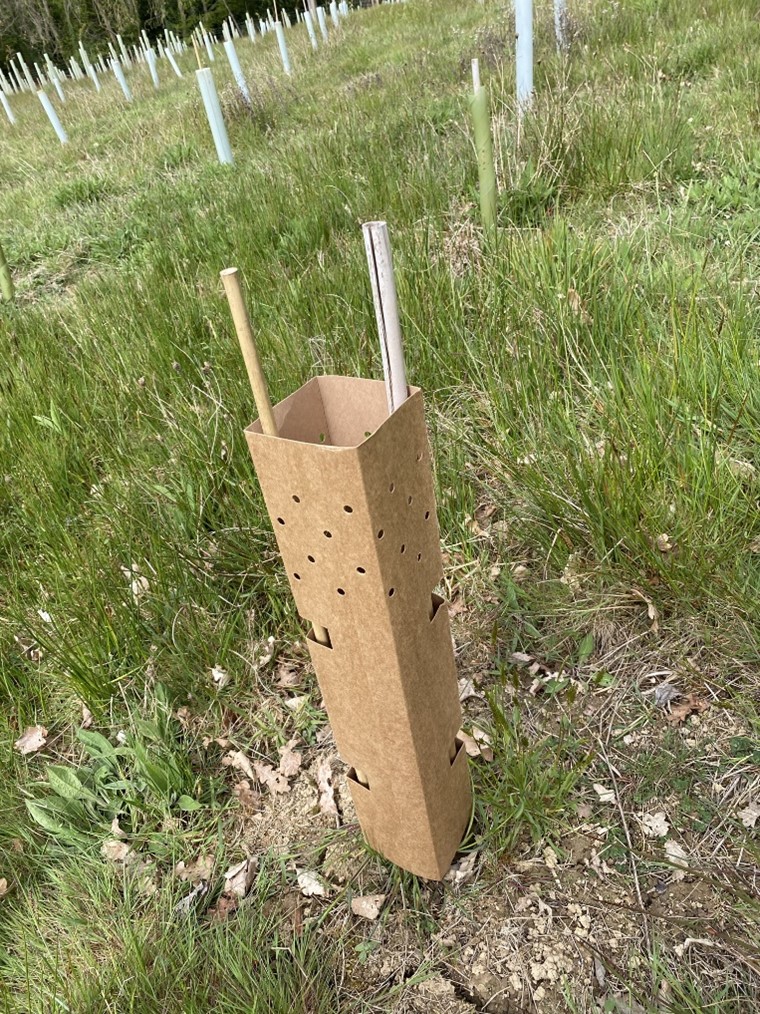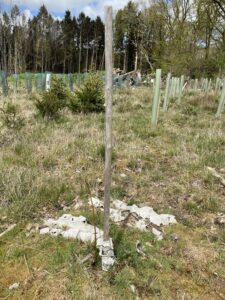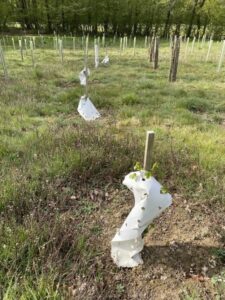The Egg Box Type Cardboard
As I have described in other articles, were a little too good at degrading. They are similar to egg box material and supported by a wooden stake. With consistent wetting and drying, the material lost structural integrity mostly within a year. One major issue, as per initial advice, was the tubes were stacked atop each other to make a 1.2m guard. However, this didn’t work and over time the lower tube crumpled under the weight of the one above.
Thin White Cardboard Guards
These white, thin cardboard guards that are coated in a thin plant-based film, initially did very well. They were added 6 months later than the rest of the trial start date. However, after 2 years, many of these have failed. It appears where the cardboard isn’t coated along edges or tears, water gets in and the board becomes heavy and collapses. They’ve also gone mouldy in places already.
Another consideration is the time taken to construct the tube from its flat packed state. I’m sure many an origami master could do far better than me, but I can’t say I know any planting contractors with this skillset. Some did come in a ready-formed glued version, but feedback from other trials is that the glue is another weak point.
Sweet Chestnut Cage
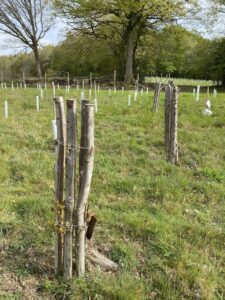
Growing Options
As time has passed, our trials have gained greater interest and additional products have been produced, so where possible we have added these at later dates. This means they cannot be a direct comparison to those that have been trialed for a longer period, but in time will be just as important. As they were sourced later, some have been applied to trees that are already well established and therefore we can’t draw conclusions about their effect on the tree itself, but only observe the material of the guard and how it acts over its lifetime. Some of these additional products are as follows:
Sheep’s Wool and Nut Resin
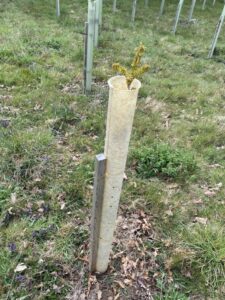
Egg Box MK2
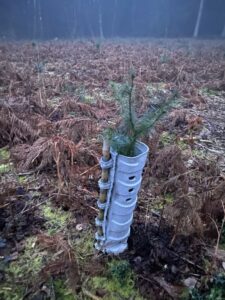
Green Cardboard Guards
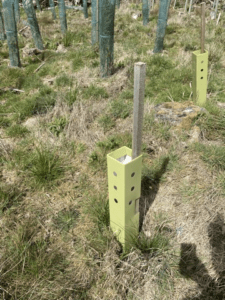
Brown Cardboard Guard
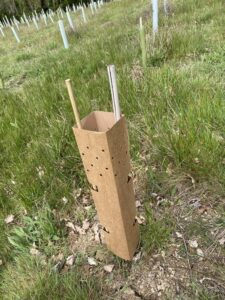
Hedging Our Bets
Our main interest is in tree guards, but we did also try some hedging guards as these can be used for trees where deer browsing is not an issue. We had three variants of these, two made from biodegradable plastic and one from cardboard.
Biodegradable Plastic Hedge Guard
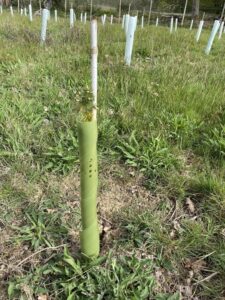
Cardboard Hedge Guard
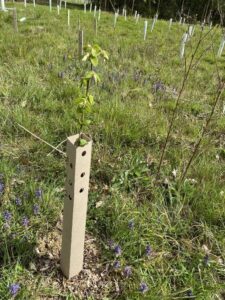
Bio-degradable Plastic Spiral
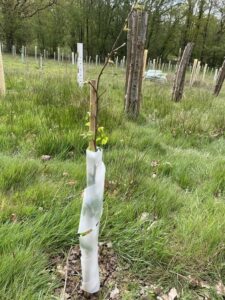
Tying up loose ends:
Plastic tree tubes aren’t the only issue when looking at the use of plastic within forestry. Cable ties, used to secure the tube to its support, do a fantastic job as any self-respecting amateur mechanic will tell you. However, these are made from nylon and are seemingly even harder to recycle than the tree tubes.
One option is to return to the original method first used when tree tubes were invented. This involves using a piece of wire passing through the tube, around a support and then twisted together to tighten and secure itself. This is the method used in the sheep’s wool and nut resin option aforementioned. The advantage this offers is that it degrades through oxidation (rusting) and does so quicker than nylon will degrade. A disadvantage is the potentially higher carbon footprint of producing these in the first place.
In the wider industry:
Shortly after setting up our trials, we were approached by the Yorkshire Dales Millennium Trust (YDMT) to speak at a conference in Leeds. YDMT had been forward thinking enough to gather an entire industry group on the issues of plastic use in forestry. The group brought together industry colleagues that were all facing the same issue. Some had already, and some have since, set up other trials on other sites with more alternative options and there are now several trials underway across the country, being managed by different parties and all feeding into The Forestry Plastics Working Group.
The group has been a great success so far. Together we have provided support and funding to Forest Research to facilitate a larger, more scientific trial, looking at all available alternative shelters that we can get hold of.
It is important that others take on the challenge of trialling shelters too, as currently so many tree tubes are used in the industry for so many different clients, on so many different sites. One relatively small-scale trial alone couldn’t possibly cover all the bases.
The Woodland Trust has been an important ally to the Forestry Plastics Group from the early days and have set up their own trial that has also been running for some years now. Other organisations such as the Forest Canopy Foundation combining knowledge from several woodland management companies is also running trials.
Of course, using a non-plastic alternative doesn’t solve all our problems. It still leaves millions of the existing plastic tree guards out in the environment. To combat this, a leading tree tube manufacturer is offering a recycling service which some members of the group have already utilised. Unfortunately, the results have been mixed.
As a new offering, costs for the recycling service are high and it seems capacity is limited. Other agricultural recyclers may also be able to take tree tubes, but the high level of labour involved in removing, cleaning, packaging and transporting them is likely to be a serious hurdle.
As a group we are also discussing the wider issue of using plastics in forestry. This includes the use of plastic planting bags, which can be very difficult to recycle when used with treated trees.
To conclude:
When asked what my advice is at the moment, regrettably I still say use a plastic guard, but always ensure to either re-use or recycle it at the end of its life. I think that is the best option currently for two reasons.
- We just don’t know yet how the existing alternative materials will perform over the necessary 10-year lifespan.
- Plastic tubes definitely work, and we don’t yet have the evidence to say that these alternatives work just as well.
The coming years research and trials should certainly change this and may well lead to a change in culture as well. Perhaps we will be content with guards that last only 2-3 years until we replace them. Or perhaps we will find a fantastic alternative that meets all of our needs.
There is also a shift in thinking required. We often automatically use guards without question and without considering if it’s really the best option. Deer fencing or increased beat up rates should be considered as part of the plan. Many people are also asking if more natural options are out there, for example using sacrificial species or barrier species to push browsers away from the new stock. Research is also underway into the use of a spray-on chemical deterrent.
Careful thought should be given, however, to avoid a knee jerk reaction away from plastic to an alternative that may be more damaging for other reasons, or simply push the problem elsewhere.
It was recently reiterated to me to use the waste hierarchy when assessing waste issues. Although simple, this is a very good tool to remind us how to best approach these issues and how to most effectively reduce our impact on the environment.
Reduce, is the waste really needed in the first place?
Reuse, can the waste be reused?
Recycle, recycle the waste as efficiently as possible.
Recover, can the waste be sent for energy recovery?
Only then should the waste be disposed of.
About me- My current role has taken me into developing projects for the Woodland Carbon Code but I maintain a keen interest in the practicalities of forest management and alternative tree tubes of course! For more information please feel free to get in touch with me at alex.mackinnon@carbonstoreuk.com.
Tilhill is part of the Forest Plastics Working Group
Read more
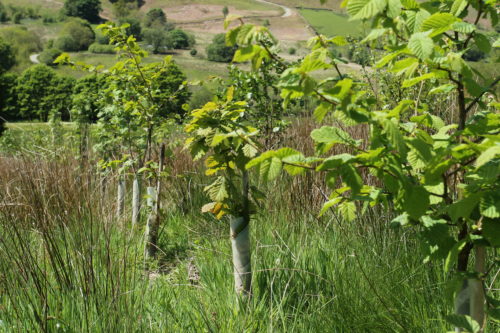
Forestry & Woodland Plastics
Find out moreSee Forestry & Plastic Waste Update
Current media attention is high on the use of plastics within forestry and woodland management.
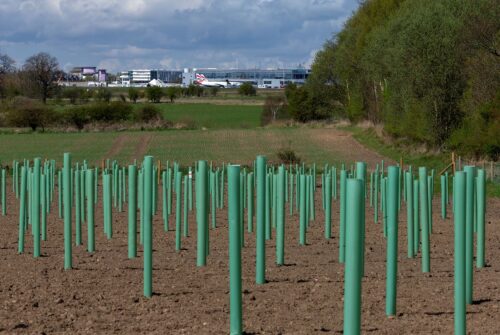
Within Tilhill we have been proactive in looking for ways to recycle tree bags and trialling alternatives to plastic tree tubes.
When we look at how we manage these products from sourcing to disposal we must consider the waste hierarchy: Find out more.
Find out more


